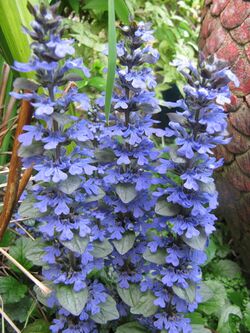Biology:Ajuga turkestanica
| Ajuga turkestanica | |
|---|---|

| |
| Scientific classification | |
| Kingdom: | Plantae |
| Clade: | Tracheophytes |
| Clade: | Angiosperms |
| Clade: | Eudicots |
| Clade: | Asterids |
| Order: | Lamiales |
| Family: | Lamiaceae |
| Genus: | Ajuga |
| Species: | A. turkestanica
|
| Binomial name | |
| Ajuga turkestanica (Regel) Briq.
| |
| Synonyms[1] | |
| |
Ajuga turkestanica is a herbaceous flowering plant native to Central Asia. It was first described in 1894.[1]
Description
A. turkestanica is a perennial herbaceous plant reaching heights between 40 and 60 cm.[2] The plant is typically found in populations between 10 and 300, and appear more frequent within Artemisia complexes. The leaves are an elliptical oblong shape, straight-edged and with a pointed tip. It will flower between May and June. The flowers are small, pink, and located within the axil of two leaves. The fruit consists of four nuts, a characteristic of the Lamiaceae family. Fruit is born by the end of May.[citation needed]
Distribution
A. turkestanica is native to the Pamir-Alay mountain ranges of Central Asia, notably within the Surxondaryo Region of Uzbekistan. The species has also been observed within the low mountain regions of southern Tajikistan. It grows in rocky clay conditions up to elevations of approximately 2500 metres.[citation needed]
Uses
A. turkestanica, alongside many other Ajuga species, is claimed to have medicinal effects.[3][4][5][6] The species has traditionally been used by local charmers (herbalists), who prescribe the herb as a tonic.[citation needed] Today, many bodybuilding supplements containing extracts of A. turkestanica can be found on the Internet.[2] A. turkestanica contains ecdysteroid derivatives such as turkesterone, though whether these produce anabolic effects in mammals is unclear and research has shown inconsistent results.[7][8][9][10]
References
- ↑ 1.0 1.1 "Ajuga turkestanica (Regel) Briq.". 2013. http://www.theplantlist.org/tpl1.1/record/kew-5414.
- ↑ 2.0 2.1 "Ajuga Turkestanica.". 2015. https://dermatology.mhmedical.com/content.aspx?bookid=2812§ionid=244978778.
- ↑ "Bugle, Common". http://www.botanical.com/botanical/mgmh/b/buglec82.html.
- ↑ "Medicinal Weed: Ajuga, aka Bugleweed". 23 April 2014. https://www.newlifeonahomestead.com/medicinal-weed-ajuga-bugleweed/.
- ↑ Traditional Folk Remedies. Century. 1987. p. 95. ISBN 978-0-7126-1731-4.
- ↑ "Ethnomedicinal Uses, Phytochemistry, Pharmacology, and Toxicology of Species from the Genus Ajuga L.: A Systematic Review". The American Journal of Chinese Medicine 47 (5): 959–1003. 2019. doi:10.1142/S0192415X19500502. PMID 31416340.
- ↑ "Ajuga turkestanica increases Notch and Wnt signaling in aged skeletal muscle". European Review for Medical and Pharmacological Sciences 18 (17): 2584–2592. 2014. PMID 25268108.
- ↑ "The minor ecdysteroids from Ajuga turkestanica". Phytochemical Analysis 26 (5): 293–300. 2015. doi:10.1002/pca.2563. PMID 25953625. https://hal.sorbonne-universite.fr/hal-01157962/file/Guibout_2015_The_Minor.pdf.
- ↑ "Phytoecdysteroids Do Not Have Anabolic Effects in Skeletal Muscle in Sedentary Aging Mice". International Journal of Environmental Research and Public Health 18 (2): 370. January 2021. doi:10.3390/ijerph18020370. PMID 33418916.
- ↑ "Combined Effects of Exercise and Phytoanabolic Extracts in Castrated Male and Female Mice". Nutrients 13 (4): 1177. April 2021. doi:10.3390/nu13041177. PMID 33918334.
Wikidata ☰ Q4179955 entry
 |

